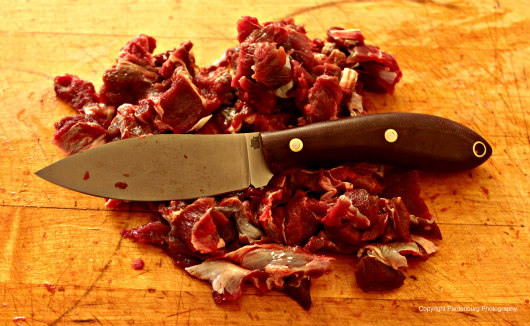Once you use a Canadian-style blade, you’ll wonder why it took so long to discover it.
by Leon Pantenburg

The L.T. Wright Large Hunter relies on a time-tested design with modern materials.
That’s the situation for the L.T. Wright Large Northern Hunter.
The Hunter features the Canadian blade design, and I find that style to be one of the most practical designs imaginable. I’ve used my Tundra for just about everything since it came on the market in 2015. Prior to that, I used a Bark River Canadian Special, and before that, a Cold Steel Canadian. All these knives were used for hunting or cleaning fish and small game.
Also known as a leaf blade, the Canadian design had roots in the Northwest fur trade of the mid-1700s through early 1800s. A good skinning knife was essential to the hide hunter and trapper, and blades were sold by the barrel at the trading posts.
Green River knives were made in Greenfield, Massachusetts by J. Russell & Co. The factory was started in 1832-34 to make butcher and kitchen knives. Close to 60,000 Russell Green River knives per year were shipped to the West and Northwest for several years. Among the most popular is the Green River scalper, skinner and butcher used by the American mountain men.
A trapper would modify his butcher knife to the shape he wanted with a file. Eventually, this design morphed into what we know as the Canadian style.
L.T. Wright Large Northern Hunter Specifications:
- Overall Length: 9″
- Blade Length: 4.25″
- Blade Thickness: .120″
- Blade Steel: AEB-L Stainless @ 59-60 RC
- Weight: 6 oz
- Made in USA
- High quality dangler sheath included

The handle is large, generous and effective.
The good stuff:
Blade design: It would be really hard to beat the Canadian design for an all-around knife. The style is just about perfect for that initial spine-down, belly-up cut that opens up the abdominal cavity while field dressing a deer. The belly and tip are ideal for skinning, particularly around the neck and front shoulders.
My favorite blade length is somewhere between four and five inches. This is a good length for working inside the abdominal cavity of a downed deer or elk. Any larger gets to be cumbersome, and shorter may not do the job.
Handle: The handle fits my glove-size large hands very well. It’s easy to see that this knife was designed by a hunter – as a skinner it will work really, really well. I like to put my index finger on the spine when skinning, and the handle fits the hollow of my hand perfectly. It’s about six months until deer season, so I’ll have to wait to try it in the field.
When it comes to a user knife handle, I go with Micarta. Other materials are available, but Micarta is bullet proof and the material gets almost tacky when wet. That’s what you’re looking for in a handle that will get bloody from field dressing big game, or slimy from cleaning fish.
Micarta is also available in a variety of colors. Mine came in maroon. At some point, it will probably end up with my niece, a deer hunter, outdoorswoman and alumnus of Mississippi State University. Those Bulldog alums bleed maroon and white.
Steel: This is my first experience with AEB-L Stainless @ 59-60 RC, and I’m liking it so far. Stainless is a good idea in wet, humid climates like Mississippi, where I hunt whitetail deer. The steel held an edge well last week, even after whittling a bunch of white oak stakes, and cutting several bamboo fishing poles. The knife sharpens easily.
Spine: The spine is ground at a 90-degree angle, like an ice skate. This makes that edge useful for processing tinder, shaving pitchwood and scraping a ferrocerium rod. All these tasks can spare the opposing sharp edge. Nobody needs a guthook or a sawblade on their hunting knife.

The .120 inch thick blade is an effective field dressing and meat cutting tool.
Blade thickness: You don’t need a thick blade on a hunting knife. For that matter, you don’t need a thick blade for most survival knife tasks! At .120 inch, the Large Northern Hunter’s blade is about right for all meat cutting, butchering and field dressing tasks.
Made in the USA: All L.T. Wright knives are made in Ohio. Call the factory and someone with a Midwestern accent answers the phone. The workers make a respectable craftsman’s wage, pay local, state and federal taxes, and contribute to their local economies.
Warranty: Unconditional. ‘Nuff said.
Do you need a L.T. Wright Large Hunter?
The hunt isn’t over when you harvest the big game animal. If you are going to enjoy the meat, the animal must be promptly gutted and skinned and cooled down. If you are hunting the back country, you will be limited by how much you can carry, and you may only have room for one knife.
So you need an effective hunting tool that can double as a survival knife in a pinch. I believe the Large Northern Hunter can be that effective hunting knife.
Buy this review knife at a discount!
Please click here to check out and subscribe to the SurvivalCommonSense.com YouTube channel – thanks!





Leave a Reply